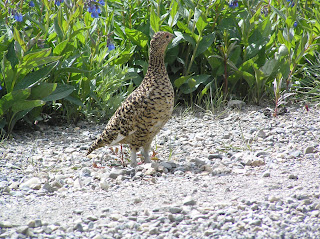For ten marvelous days this past June, I was writer-in-residence at Denali National Park. Here are some excerpts from the journal I kept.
Day 1. Driving to the cabin, I saw a group of fourteen caribou being pestered by a pair of long-tailed jaegers—move along! move along!—they swooped and shouted, protecting their territory. Focusing my binocs, my elbow hit the car horn and the caribou stopped dead, looking around for the source of the noise. I thought: “Strike one for me.”
After moving my stuff into the 14’x16’ cabin, equipped with a double bunk bed, a propane refrigerator and stove, I heard some loud talk and laughter coming from the river. Two naturalist filmmakers, Kennan and Karen Ward, were watching four or five fox kits poke their heads out of the den holes and peak down from over the top of the hill. The human noises we made seemed to intrigue and puzzle them—what strange two-legged creatures!?
Day 2. Scanning with binocs at the river, I noticed an odd boulder on the ridge-line across the way, past the East Fork bridge. It turned out to be a golden eagle, in profile against the sky. After about ten minutes, two more eagles circled in, looking through the blue haze of distance like shadowy ghost-birds.
Day 3. This morning, driving back from a hike at Tatler Creek, I saw a mother ptarmigan and two tiny chicks crossing the road. When I stopped I could hear her motherly peepings to hurry them along. On this stay in the park, I find my interest in bears and moose is somewhat less, while my attention to smaller creatures grows.
I also have more time to sit and take in the landscape. The hills I can see from the cabin window at the east end of Polychrome Pass, for instance—looping green and brown with dots and streaks of snow, rising up to snow-splashed peaks, with shifting clouds and cloud-shadows, and flitting and foraging in the foreground magpies, ground squirrels and rabbits.
Day 4. After showering at the staff washhouse at Toklat, I continued out to the Eielson Visitor’s Center and hiked up toward the ridge. The wildflowers were amazing—such varieties of color and shape, the alpine forget-me-nots an almost neon blue. On the drive back I saw the Wards’ camper pulled over, with their camera set up. A sow grizzly and two first-year cubs—tiny by comparison—foraged in the middle-distance. She was blond and they were both brown and when she lay back for them to nurse I snapped a picture, though it was probably too far for me to get a decent shot.
While in the park, I’m reading Robert Richardson’s fine book on Thoreau (Henry Thoreau: A Life of the Mind). It turns out that Thoreau experienced true wilderness not at Walden Pond—a short stroll from his home in Concord—but rather on Mt. Katahdin in northern Maine, where, alone in howling wind, surrounded by barren rock, feeling sick and worn-out, he encountered a nature that was in no way hospitable to our species. He realized that nature has a range of experiences to offer and concluded that in essence there isn’t just one nature, but two. The familiar one, almost domestic, offers a healing relief from the petty distractions and restrictions of human communities, but, at the other end of its range, lies a hostile, barren world, which he called “Demonic Nature.” Thoreau felt that this harsh and alien environment was also important to humans, because, as he wrote, “We need to witness our own limits transgressed.”
And reading this, I realized that at the present time, while I’m relaxing in the cabin or cruising up and down the park road picking from a menu of easy to moderate hikes, there are climbers taking on Mt. McKinley itself, voluntarily putting their lives at risk, testing their limits and in some cases having their limits transgressed.
Day 5. A little after one a.m. the excited barking of a young fox got me out of bed. I saw it dash toward the den, pause and bark as if calling for a parent or sib, then turn and race back into the brush, where it continues to bark as I write this. A first kill perhaps? The look on its face—a mixture of terror and pride—as if its young life had stumbled on something utterly new and amazing!
The barking isn’t like a dog’s and could easily be mistaken for a crow cawing—which I did at first. But the barks are longer than caws and the silence between more spread out. Foxes are usually thought of as quiet and stealthy, but clearly this one feels it has something to crow about.
(To Be Continued)

.jpg)

.jpg)
.jpg)
John, I appreciate your inclusion of Thoreau's responses to two kinds of nature and his quote: “We need to witness our own limits transgressed.” That's how I often feel on Alaska trips.
I hope others are inspired by your posts and Denali writer-in-residence journal to seek out similar opportunities!